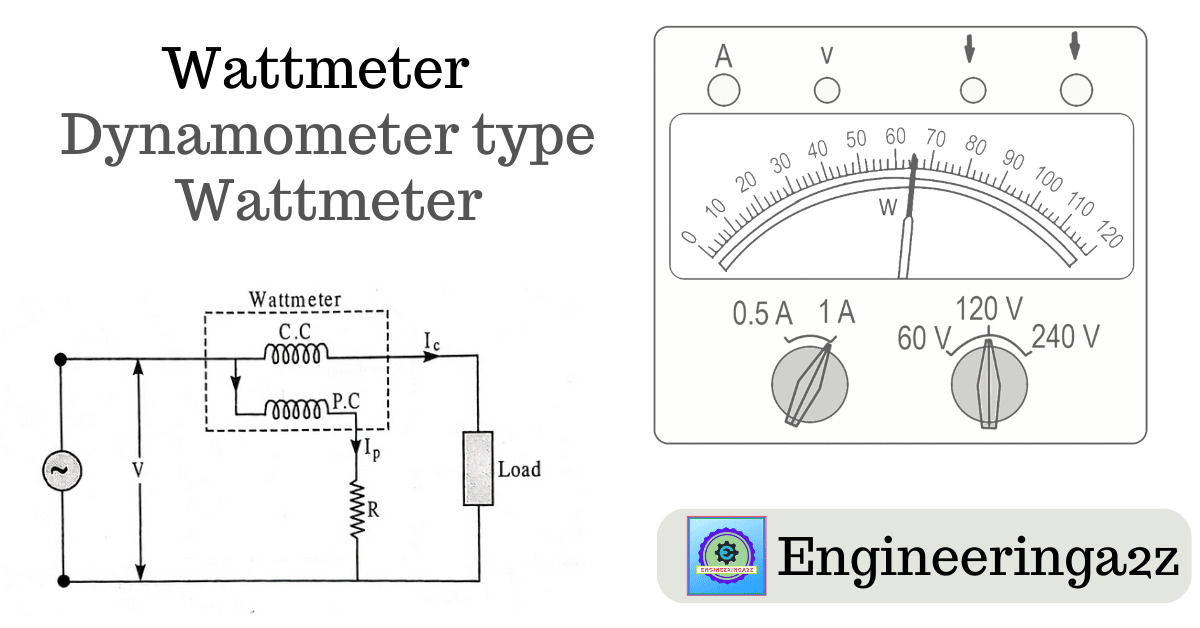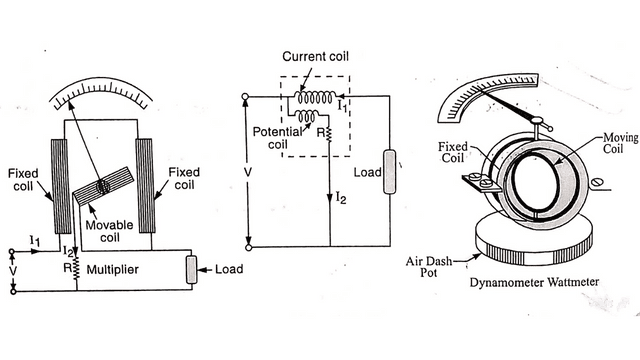
Table of Contents
Wattmeter
The instrument which is used for the measurement of power is called as wattmeter. The wattmeter consists of two coils i.e. current coil CC and pressure coil PC. The operating torque is produced due to the interaction of currents in current coil as well as in pressure coil. The figure shows the connections of the wattmeter in an electrical circuit.
Construction of wattmeter

Types Of Wattmeter
There are mainly four types of wattmeter :
- Dynamometer Wattmeter
- Induction wattmeter
- Electrostatic wattmeter
- Thermal wattmeter
Dynamometer Wattmeter
Introduction of Dynamometer type Instruments
The permanent magnet moving coil instrument and these devices are extremely similar. In fact these are the modified form of the moving coil instruments. In these instruments, the magnetic field is not produced by permanent magnet but is replaced by air cored coil (Two air cored fixed coils) which carry the current to be measured.
These devices primarily consist of a moving coil made of fine wire that is placed in the magnetic field created when the fixed coils carry current. When using the instrument with A.C., the coils are typically air cored to prevent hysteresis, eddy currents, and other problems.
These devices can be used as voltmeters or ammeters, although they are typically used as wattmeter. They are appropriate for both AC and D.C. systems.
Operating Principle of Dynamometer Wattmeter
This is an indicating type instrument. The dynamometer wattmeter can be used to measure the power in an electric circuit . This measures the power in watts or kilowatts. This is universally used for the measurement of D.C. as well as A.C. power. When it is used as watt meter, the fixed coil in dynamometer type wattmeter are connected in series with the load (as shown in Figure ) and carry the load current whereas the moving coil (the pressure coil of a dynamometer type wattmeter) is connected across the load and carries current proportional to the voltage across the load. Dynamometer type wattmeter consists of fixed coil is known as current coil and the moving coil is known as potential coil.

When a current carrying moving coil is placed in the magnetic field produced by the current carrying fixed coil, a force is exerted on the sides of coil of the moving coil, thus the deflection takes place and so the pointer moves over the scale. The pointer comes to rest at a position where controlling torque is equal to deflecting torque. The reversal of current reverses the current in current coils, both fixed coil and pressure coil (moving coil) so the direction of the deflecting torque remains unchanged.
Hence such instruments can be used on d.c. as well as a.c. power. The controlling torque is provided by springs which also serve the additional purpose of leading current into and out of the moving coil. Air friction damping is used in such instruments.
Torque Equation of Dynamometer Wattmeter
- Deflecting Torque in case of D.C. System
Let, V = Voltage across the load
IL=Load current
If=Current through fixed coil
Im=Current through moving coil
Since fixed coils carry load current and moving coils carry current proportional to the voltage,
If ∝ IL and Im ∝ V
Deflecting torque, td ∝ If*Im
∝ IL*V ∝ Load Power
2. Deflecting Torque in case of A.C. System
Consider that the watt meter is connected in an a.c. system to measure power. Let at any instant, current through the load is i and voltage across the load is v, the power factor be cosΦ(lagging)
Then, v = Vm sinΦ
and i = Im sin(θ-Φ)
Instantaneous deflecting torque ∝ If*Im ∝ i*v or v*i
Due to inertia of the moving system, the deflection will be proportional to the average torque.

Under steady conditions, Td = Tc
θ ∝ Load Power
Hence such instrument have uniform scale.
Advantages of Dynamometer Wattmeter
- These instruments may be used both on A.C. and D.C.
- By careful designing, high accuracy can be obtained i.e., Instruments with errors as low as 0.1% to about 2% can be produced.
- These instruments have uniform scale.
Disadvantages of Dynamometer Wattmeter
- These instruments are expensive.
- The operating field being weak, the readings are affected by stray fields.
- The torque is small.
Errors in Dynamometer Wattmeter
- Error due to the friction of moving system.
- Error due to the fact that springs are subjected to ageing.
- Error due to connection of potential coil circuit.
- Error due to temperature rise thereby increasing resistance of the moving and fixed coils.
- Error due to eddy currents.
Frequently Asked Questions (FAQs)
-
What is the two types of dynamometer type wattmeter?
The two types are :
1. Suspended coil, torsion head type
2. Pivoted coil, direct indicating type -
What do you mean by calibration of wattmeter?
Calibration of wattmeter means it is a process of checking the instrument by comparing it with a standard one.
-
What is the primary use of an instrument of the dynamometer type?
The primary use of this kind of instrument is as a wattmeter.











Comments (1)
Good Work!